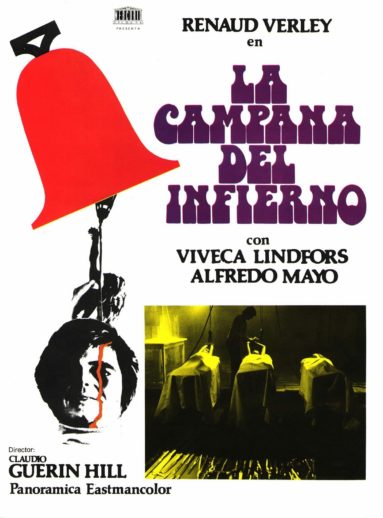 A vaguely surreal, darkly comic and deeply shocking exercise in Euro-styled anti-bourgeoisie subversion, the Spanish production A BELL FROM HELL is a one-of-a-kind gem, and one of the great unknown horror films of the seventies.
A vaguely surreal, darkly comic and deeply shocking exercise in Euro-styled anti-bourgeoisie subversion, the Spanish production A BELL FROM HELL is a one-of-a-kind gem, and one of the great unknown horror films of the seventies.
A BELL FROM HELL (LA CAMPANA DEL INFIERNO; 1973) is probably best known these days for the fact that its director Claudio Guerin Hill died on the last day of production, having either fallen or jumped from atop the bell tower that figures prominently in the film. Post-production was supervised by the esteemed Spanish filmmaker Juan Antonio Bardem (director of films like 1973’s THE CORRUPTION OF CHRIS MILLER and uncle of actor Javier Bardem). Other noteworthy participants include actors Renaud Verley (from THE DIRTY DOLLS OF KATHMANDU and THE DAMNED), Viveca Lindfors (who’d already starred in NO TIME FOR FLOWERS and MOONFLEET, and would go on to appear in CREEPSHOW, THE EXORCIST III and STARGATE) and Maribel Martin (from THE BLOOD-SPATTERED BRIDE and Augustin Villaronga’s MOONCHILD), as well as screenwriter Santiago Moncada (who also scripted Mario Baba’s HATCHET FOR A HONEYMOON, CUT-THROATS NINE and the above-mentioned CORRUPTION OF CHRIS MILLER).
The good news is that this essential film is at last available on DVD, courtesy of Pathfinder Home Entertainment. The bad news is that the print is the same poorly dubbed 92-minute one previously available from Unicorn Video (albeit this one is letterboxed). The film is a must see in any form, but I’m still anxious to experience the uncut 106-minute Spanish language version.
The rebellious Juan is released from an insane asylum, having been locked up for several years by his corrupt aunt and her three luscious but equally petty daughters, who were looking to gain the inheritance granted Juan by his dead mother. After briefly working in a slaughterhouse (he quits with the ominous words “I’ve learned enough”) Juan returns to his mother’s abandoned house, where he plans his revenge. Said vengeance turns out to be an extremely elaborate one, involving a number of complicated practical jokes whose victims encompass not just his disabled aunt (who he leaves outside to be stung by bees) but also her slimy buddy Pedro (who humiliatingly shakes Juan’s penis after he pees, having been faked out by the phony casts Juan wears on both arms) and the latter’s sexually frustrated wife (Juan shocks her into unconsciousness and then leaves a note suggesting he raped her while she was out).
All this is only the prelude, however, to the “joke” Juan pulls on his three cousins, who, via a series of carefully planned machinations, he strips, ties up and drags into the basement of his mother’s house, which he’s outfitted as a mini slaughterhouse complete with movable hooks in the ceiling and a wide assortment of deadly cutlery. It seems that Juan’s psyche has finally crossed over into murderous dementia, but he finds he can’t go through with killing his cousins…or maybe he never planned to in the first place. In any event, he’s outsmarted by his bee-stung aunt and Pedro, who brick him up in a church tower with a rope around his neck that will serve as a counterweight to a new church bell, which is set to be rung the following morning. However, just before he’s closed up the cackling Juan promises “I’ll have the last laugh”, suggesting that his final and most elaborate prank has yet to be sprung.
The premature death of Claudio Guerin Hill marked the loss of a genuinely talented filmmaker with a real grasp of the mechanics of cinema. His visuals are impressively textured, with a real sense of menace (although the abuse of the zoom lens, an unfortunate convention of the time, is a bit of annoyance). Throughout, Hill keeps us on edge by never revealing the true nature of the protagonist or his ultimate goals; we sympathize with the unhinged Juan even as we cringe at his actions, and shudder at what he might do next. The film also has a deep anti-bourgeoisie streak—a stinging rejoinder to the despotic reign of Francisco Franco, still in power at the time—worthy of Hill’s fellow subversive Spaniards Luis Bunuel and Fernando Arrabal, yet has a flow and rhythm all its own, with quite a few allusions to authors like Saki and Edgar Allen Poe (in particular the latter’s tales “The Black Cat” and “The Pit and the Pendulum”).
Since Hill died on the last day of shooting, we’ll have to credit Juan Antonio Bardem with a fair portion of the picture’s effectiveness. The latter, after all, supervised A BELL FROM HELL’S editing, which to my mind is one of its most effective components. Bardem utilizes quite a few avant-garde editing techniques—inter-cutting, juxtapositions, etc.—yet does so without ever feeling excessively self conscious or ruining the flow of the narrative, something that can be said of very few other “innovative” European horror films from the seventies.
Vital Statistics
A BELL FROM HELL (LA CAMPANA DEL INFIERNO)
Cinema Arts Entertainment
Director: Claudio Guerin Hill (with assistance from Juan Antonio Bardem)
Producer: Claudio Guerin Hill
Screenplay: Santiago Moncada
Cinematography: Manuel Rojas
Editing: Magdalena Pulido
Cast: Renaud Verley, Viveca Lindfors, Alfredo Mayo, Maribel Martin, Nuria Gimeno, Christine Betzner, Saturno Cerra, Nicole Vesperini, Erasmo Pascual
